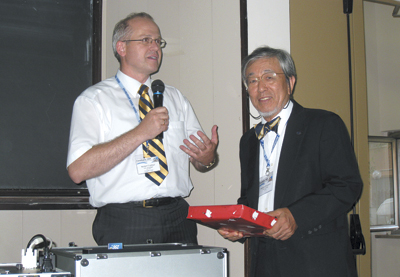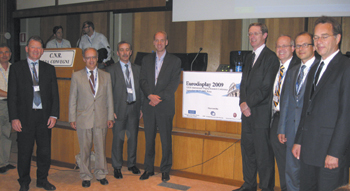Eurodisplay 2009 Takes Place in Rome — New LCD and Plasma Developments, Environmental Concerns Highlighted
by Jyrki Kimmel
The 29th International Display Research Conference (IDRC), Eurodisplay 2009, took place in Rome, Italy, on September 14–17 in scenic surroundings at the Consiglio Nazionale delle Ricerche (CNR) and Università di Roma "La Sapienza" (University of Rome). Almost 250 attendees were on hand to learn about the latest display science and technology developments amid the splendor of the Eternal City. Among the prominent themes at the conference were environmental and energy-saving issues. Many of the technologies discussed will provide better energy efficiency for the future needs of consumers. In all, more than 150 presentations arranged in three parallel session tracks, plus a poster session, provided a broad view of display science and technology today, as well as a look at technologies that will be powering the products of tomorrow.
The program kicked off with a one-day workshop consisting of several seminars. Werner Becker from Merck in Darmstadt focused on the environmental aspects of display technology and liquid-crystal panels in particular. Well-known RoHS and REACH laws govern the application of chemical compounds in consumer goods, from the production phase through usage to the disposal and recycling of the devices. These are important considerations for display-panel makers, and Becker's talk described how Merck is concentrating on meeting these standards in several ways, with a fully recyclable LCD module, processes used in the recovery of noble metals and catalyst materials, and the incineration of hazardous (non-display specific) waste.

Program Chair Norbert Fruehauf (left) presents a gift to Professor Shunsuke Kobayashi in a special Eurodisplay 2009 session honoring Kobayashis 77th birthday.
Other seminar highlights:
• Kazuaki Tarumi, also from Merck, provided a comprehensive overview of new liquid-crystal materials that advance the technology of display panels, from well-known, basic configurations to energy-efficient, fast, and high-contrast electro-optic effects such as PS-VA and "blue-phase" LCDs.
• Vladimir Chigrinov from the Hong Kong University of Science and Technology gave a presentation about new trends in LC devices. He highlighted key aspects of field-sequential color LCDs, photo-alignment technology, transflective LCD technology, and flexible LCDs, and also provided a glimpse into applications of LC technology used in optical communications.
• John Chen from ITRI in Taiwan discussed flexible display technology and presented recent results in web-processed ChLC display technology as well as flexible active-matrix display technology. These displays can provide rugged, economic alternatives in applications where high image quality is not yet absolutely required.
• Eugen Onac from Philips described innovative architectures for the ultimate in LCD-TV applications. His talk spanned TV system-development aspects from backlight alternatives to the color-filter matrix to obtaining best front-of-screen technology through novel hybrid color and backlight addressing.
• Ryuichi Murai from Panasonic provided an industry outlook regarding plasma and also a description of the evolution of PDP technology. It seems that in the near future, plasma panels will be able to provide energy efficiency that rivals that of LCDs, with new technology that triples the energy efficiency of the plasma panels introduced last year.
• Ian Underwood from the University of Edinburgh touched on a very topical area with his presentation on pico-projectors. He gave a structured overview of pico-projector technology alternatives as well as the commercial offering of today. It seems that the commercial opportunities are awaiting the integrator companies, as the killer application is yet to be found.
• Finally, in the last talk of the workshop, Eugen Onac presented the state of the art of autostereoscopic display technology, concentrating on switchable 2-D/3-D lenticular screens and display systems. In contrast to 3-D systems based on adaptations of commercially available panels through the use of polarizing or shutter glasses, these displays offer a 3-D experience without additional glasses. Their drawback is that no fully artifact-free technology for switching back to 2-D exists as of today.
Four keynote presentations were the highlight of the start of the Symposium. Augusto de Albuquerque from the EU Commission explained the European Framework Programs 6 and 7, which involve funded research for displays and related technology areas. A funding opportunity in excess of 100 million euros has been invested with regard to upcoming calls for proposals. Kari Kulojärvi from the Nokia Devices Business Group presented a view of the mobile phone as a window to the Internet. Because the usage model of mobile phones is becoming more and more data-centric, with talk use narrowing toward 10% of actual use time, displays are becoming ever more important in achieving an optimal user experience. Alasdair Jelfs from Merck investigated the display material supplier's perspective on the industry, and Didier Zwierski from Philips TV looked at television now and in the future. He highlighted the trends toward wide cinemascopic TV displays with a 21:9 aspect ratio, as well as trends toward 3-D and touch-interface TVs that will be connected to the Internet.
A special session was organized in the honor of Professor Shunsuke Kobayashi's 77th birthday, highlighting his achievements in the fieldof liquid-crystal displays and the way in which his work has had far-reaching implications for the flat-panel devices of today. He was introduced by acting session chair Hoi-Sing Kwok and received a standing ovation. Many of Prof. Kobayashi's former colleagues and students came together for this special occasion.
In the Markets and Technology Outlook session, analyst Sweta Dash from iSuppli Corp. discussed the current state of the display market, which looks as though it will recover from this year's dip in 2010. Barry Young, Managing Director for the OLED Association, presented a look at the OLED industry in the current difficult economic environment, while also predicting multi-billion dollar revenues in the future. With five OLED suppliers in 2015, predicted Young, the revenues could be up to $US12 billion. Peter Knoll from the University of Karlsruhe described automobile night-vision systems and user experiences with different classes of related technology, offering some interesting insights into the utility of simple indicator systems and augmented reality in terms of providing driver alerts for night-vision displays.
On Wednesday, September 16th, a sold-out special event included a historical tour following a dinner at the top of the Capitolium hill, overlooking Rome's skyline. The guests enjoyed a thorough presentation on the history of the city and were given an opportunity to explore the famous sights close at hand on the guided walk to the Capitolium. The dinner itself was an event to remember, as top-level Italian cuisine was served accompanied by appropriate wines for the occasion.
In conclusion, it appears that Eurodisplay 2009 just set a new standard over prior Eurodisplay conferences in terms of location, scientific content, and general proceedings. The information presented at this conference was extraordinarily timely and invaluable to anyone involved in displays. The Eurodisplay 2009 team worked very hard to bring about this conference, and we are confident that the next team from the SID France Chapter will rise to the challenge and host an even better Eurodisplay Conference in Bordeaux in 2011. •

The keynote presenters and conference organizers behind Eurodisplay 2009 helped make the conference a great success. From left: Gerrit Oversluizen, Augusto de Albuquerque, Didier Zwierski, Kari Kulojärvi, Alasdair Jelfs, Norbert Fruehauf, Jyrki Kimmel, and Paul Drzaic.
Jyrki Kimmel is with Nokia Research Center in Tampere, Finland. He is General Chair for Eurodisplay 2009.